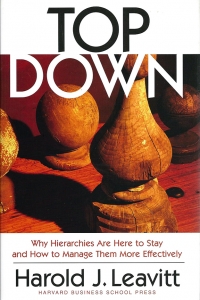
Connective Leadership: Managing in a Changing World
By Jean Lipman-Blumen
ISBN-13: 978-0195134698
In this tour de force, organizational sociologist Jean Lipman-Blumen explores how leadership must change in the emerging Connective Era. Everyone and everything are connected, but diversity still drives us to express our separate identities. Connective leaders, who can find the common ground among many different, even antagonistic, but interdependent groups, will have a decided edge. They do not ask, “Who will follow me? Who will support my dream? Who is our enemy?” Connective leaders ask instead, “What are our common challenges? How can we meet them? How can we share our dreams, improve our world, and find real meaning in our lives?”
Connective leaders move beyond narrow individualism, welding the advantages of diversity to the benefits of interdependence through political savvy and integrity. To do so, they use “de-natured Machiavellianism,” a powerful ethical tool for bringing together groups with seemingly conflicting agendas. Using a very broad set of leadership behaviors, connective leaders seek active constituents, not passive followers. They assemble changing coalitions for different tasks. They allow for ambiguity and disagreement. In the process, their constituents discover coherence, even ennoblement, within their daily work and lives.
The Connective Edge includes interviews and case studies of leaders in for-profit and not-for-profit organizations, as well as in government. The book features interviews with a fascinating range of corporate leaders, from The Body Shop’s Anita Roddick, to Perot Systems’ Mort Meyerson, Schroder’s Robert Fisher, and former Herman Miller CEO Kerm Campbell, to Drucker Foundation for Non-Profits CEO Frances Hesselbein and Carsey-Werner TV producer Marcy Carsey. Based on 25 years of research, the book explores the findings from survey data on more than 2000 male and female executives gathered with instruments specifically designed for measuring connective leadership behavior.
Binding theory to practice, Lipman-Blumen offers leaders an exciting repertoire of leadership strategies appropriate for success in the Connective Era. This is a book for executives, organizational development professionals, consultants, social and behavioral science researchers, and individuals who want to understand their own leadership potential and the behavior of leaders around them.
“Not since James McGregor Burn’s book, Leadership, have I read a work that moves so easily from one social system to another. Quite simply, a masterpiece.”
-Warren Bennis, founding chairman, The Leadership Institute at the University of Southern California, and author of Why Leaders Can’t Lead an An Invented Life
“Finally – a brilliant, readable, instructive, and pathbreaking book on leadership that does not grotesquely oversimplify this paramount task/job in society. Dare I say it: Jean Lipman-Blumen’s rich, magisterial ‘The Connective Edge’ is a ‘page-turner’!.”
– Tom Peters, president, The Tom Peters Group
“Anyone working with the Overseas Chinese Network should read this book carefully because connective leadership strategies, rather than mechanical control systems, are more likely to yield success in these interactions and relationships. If you are competing against this network, you need to know why connective leadership makes it so strong. “
– Po Chung, chairman, DHL International (H.K.) Ltd.
“This is a fantastic book that cuts across functions of leadership in corporations, political life, and throughout society. The Connective Edge opens the door to a true process of empowerment for all, reminding those in power that ‘leaders must lead.'”
– Maria de Lourdes Pintasilgo, former prime minister of Portugal
“A must-read for the leaders in the swirling, rapidly changing world of organizations today.”
– Mort Meyerson, chairman and CEO, Perot Systems Corporation
“A brilliant work, full of important insights and illuminating in every way”.
– John W Gardner, consulting professor, School of Education, Stanford University, Former Secretary of the U.S. Department of Health, Education, and Welfare (DHEW), and founder of Common Cause.
 The Allure of Toxic Leaders: Why we follow destructive bosses and corrupt politicians – and how we can survive them
The Allure of Toxic Leaders: Why we follow destructive bosses and corrupt politicians – and how we can survive them
By Jean Lipman-Blumen
ISBN: 0195166345
Why do we knowingly follow, seldom unseat, frequently prefer, and sometimes even create toxic leaders?
A brilliant look at why we follow leaders from “charming rascals” to cynical despots and how to avoid their toxic embrace
Toxic leaders — such as Jeffrey Skilling at Enron, Al Dunlap (“Chainsaw Al”) at Sunbeam, or Saddam Hussein of Iraq — have always been with us, and many books explain what makes them tick. But in The Allure of Toxic Leaders, Jean Lipman-Blumen explains what makes the followers tick, exploring why we tolerate-and remain steadfastly loyal to–leaders who are destructive to their organizations, their employees, their nations, and their constituents.
Why do we knowingly follow, seldom unseat, frequently prefer, and sometimes even create toxic leaders? Lipman-Blumen argues that these leaders appeal to our deepest needs, playing on our anxieties and fears, on our yearnings for security, high self-esteem, and significance, and on our desire for noble enterprises and immortality. The author explores how psychological needs-such as the desire to be at the heart of the action, to be an insider–can often make us susceptible to toxic leaders. She describes how followers inadvertently keep themselves in line by a set of insidious control myths that they internalize. In addition, outside forces-such as economic depressions, political upheavals, or a crisis in the company-can increase our anxiety and our longing for charismatic leaders. Equally important, Lipman-Blumen shows how followers, mired in the swamp of toxic leadership, can learn critical lessons for the future and survive in the meantime. She discusses how to confront, reform, undermine, blow the whistle on, or oust a toxic leader. And she suggests how we can diminish our need for strong leaders, identify “reluctant leaders” among competent followers, and even nurture the leader within ourselves.
Toxic leaders first charm, but then manipulate, mistreat, weaken, and ultimately devastate their followers. The Allure of Toxic Leaders tells us how to recognize these leaders and identify the germ of toxicity within their “noble” visions before it’s too late.
“Easily one of the best leadership books of the 1990s was Ron Heifetz’s Leadership Without Easy Answers (1994). By explaining why followership is equally demanding, The Allure of toxic Leaders is a perfect complement.”
– The Financial Times
“A remarkably comprehensive yet penetrating analysis that sees bad leadership both as morally wrong and psychologically dysfunctional, with practical strategies for reform. A sophisticated study that sees the problem as a failure of followership as well as leadership.”
– James MacGregor Burns
“Whose fault is it that we seem to have so many bad (toxic) leaders today? Jean Lipman-Blumen asserts that everyone’s to blame, especially us followers. Beautifully reasoned and intricately argued, she convincingly explains how followers help spawn toxic leaders. Fortunately, she also tells us how to get out of the trap we’re in and proposes a highly innovative model of leadership that promises a healthier future.”
– Jerry I. Porras, Lane Professor of Organizational Behavior and Change, Emeritus, Stanford Business School
“In this powerful and eye-opening book, Lipman-Blumen illuminates the darkness of the rarely understood – except to its victims – dangers of evil leadership. She proffers wise counsel and early warnings on how to detect and defend against it. I enthusiastically recommend it to all leaders – and even more, to their vulnerable followers.”
– Warren Bennis, Distinguished Professor of Business, University of Southern California, and author of On Becoming a Leader
“The Allure of Toxic Leaders provides remarkable insights into why so many destructive leaders gain and keep power. By explaining the role of followers, Jean Lipman-Blumen makes a profound statement about the nature of leadership itself.”
– Max De Pree, former CEO of Herman Miller, Inc.
“In our search for leaders, our appraisal of leaders, Jean Lipman-Blumen provides us with a powerful tool to identify, understand and analyze the toxic leader as she gives us fresh observations on our own journey to leadership.”
– Frances Hesselbein, Chairman, Leader to Leader Institute; founding President of the Peter F. Drucker Foundation for Nonprofit Management
 Hot Groups: Seeding Them, Feeding Them, and Using Them to Ignite Your Organization
Hot Groups: Seeding Them, Feeding Them, and Using Them to Ignite Your Organization
By Jean Lipman-Blumen & Harold J. Leavitt
ISBN-13: 978-0195126860
Many corporations, in their attempt to create innovative products and services, have focused on the concept of building teams. While many groups fizzle, on rare occasions the members of a group will experience an extraordinary eruption of excitement, transcending an organization’s rigid confines to achieve astonishing results. These individuals, say Jean Lipman-Blumen and Harold J. Leavitt, are lucky enough to be members of a “hot group,” a phenomenon they lucidly and enthusiastically describe in their ground-breaking new book Hot Groups.
A hot group is not a name for a newfangled team, task force, or committee. Rather, a hot group is defined by a distinctive state of mind coupled with a style of behavior that is intense and sharply focused on its ultimate goal. Stretching themselves beyond their own expectations, members of a hot group plunge into enterprises that have the potential to change, even ennoble, their own and others’ lives.
Neither trendy fabrication nor new management fad, hot groups have existed since the dawn of civilization, perhaps invigorating groups of cavemen to hunt together furiously for food before winter’s approach. Today, examples of hot groups abound in territories such as Silicon Valley, where impassioned people have blazed paths through the burgeoning computer industry. Consider the hot group that created the original Macintosh and revolutionized the personal computer market. John Sculley, who joined Apple in the early 1980s, described a “magnetic field” that surrounded the Macintosh hot group members, and Bill Gates, Microsoft’s mastermind, reported that a hot programming group to which he once belonged “didn’t obey a 24-hour clock.” Instead, they programmed for days at a time, pausing only to eat and talk about software with fellow programmers. Here also are examples of hot groups at work in other industries: the individuals that created the blockbuster TV drama “Hill Street Blues”; the Navy and civilian personnel that transformed a standard cruiser into a guided missile cruiser in less than 12 months; and even the ad hoc crisis management group advising President John F. Kennedy during the Cuban Missile crisis. Indeed, the inspiring case studies found throughout Hot Groups illustrate that well-nourished hot groups can profoundly transform any type of organization.
Still, Lipman-Blumen and Leavitt recognize the risks inherent in loosening an organization’s structural soil enough to accommodate these groups. Consequently, they address such issues as how to provide the kind of leadership required by a hot group, how to mesh a hot group with the regimented structure of the overall corporation, how managers can encourage new hot groups, and how best to cope with an overheated hot group.
Drawing on decades of research and experience with groups and organizations throughout the world, Lipman-Blumen and Leavitt have written an intensely engaging book about a phenomenon that will become increasingly important in our rapidly changing world. Expertly carving a path through this unmapped terrain, they lucidly demonstrate how managers and executives can ignite hot group sparks in their own organizations.
“I haven’t a question in my mind that ‘Hot Groups’ will be the most important management book of 99… It is wonderfully original. It is uncannily timely. It is gorgeously written. It is practical. It is very wise and authoritative.”
– Warren Bennis, Distinguished Professor,
University of Southern California
and author of Why Leaders Can’t Lead an An Invented Life
“Captures the attributes of intense, task dominated teams that energize both individual and organizational effectiveness in doing what hasn’t been done before.”
– Edward C. Stone, Director,
Jet Propulsion Laboratory
“Jean Lipman-Blumen and Hal Leavitt take the reader into the world of “hot groups,” a world they know so well but which remains elusive to most of us. Lipman-Blumen and Leavitt dissect the inner workings of “hot groups” with their boundless energy, creativity, and crystal clear sense of mission. This book will drive most readers to search for their own “hot group” experience, whether it’s to be found in their work, community, or family. An extraordinary relevant book for our dynamic but chaotic times.”
– Robert C. Fisher,
Schroder & Co. Inc
“‘Hot Groups’ makes a passionate case for injecting strategic disorder into disciplined organizations. Packed with information, it is clearly written, superbly organized, and entirely original. Anyone who has an interest in fostering quick and real organizational change to confront a rapidly transforming world will want to read it and refer to it.”
– Barry Munitz, President,
The J. Paul Getty Trust
“A new buzz term has just been spawned. It’s called “hot groups” and was coined by Jean Lipman-Blumen and Harold J. Leavitt in their recently published book…. A hot group is a group that is totally passionate about a task…Although unnamed until now, hot groups have always existed. But, with a marked demand for innovation and new products and technology, they’re more important than ever.”
– Bob Weinstein, The Washington Times

Top Down: Why Hierarchies Are Here to Stay and How to Manage Them More Effectively
By Harold J. Leavitt
ISBN-13: 978-1591394983
Authoritarian hierarchies are inevitable – So let’s learn to live with them.
Pundits have been forecasting the demise of the hierarchical corporation for decades. We denigrate those authoritarian structures as controlling, territorial, bureaucratic, and slow-and we celebrate “alternatives” that are flatter, more democratic, and networked.
But renowned organizational behavior expert Harold J. Leavitt argues that such alternative structures have not proven viable – or even desirable – and that despite its human failings, hierarchy remains the foundational shape of every large human organization. Why? Because it works. Top Down neither defends nor attacks the much-maligned hierarchy. Rather, this counterintuitive book convincingly shows that even the “flattest” of today’s organizations are really just hierarchies in disguise-and, to improve the ways hierarchies function, we must first acknowledge their inevitability.
Exploring both the benefits and shortcomings of top-down structures, Leavitt shows how leaders can reshape hierarchies to incorporate the human values and motivations that enable employees to thrive. He then offers middle managers suggestions about how best to negotiate the way through those authoritarian mazes, while maintaining their personal integrity and even finding satisfaction in their work.
From the Inside Flap
Leadership is a topic that has been well-examined by scholars, consultants, and the media. By contrast, the study of followers has been largely ignored. As this book reveals, the leader-follower dynamic is far more complex than has been previously imagined.
The Art of Followership puts leader-follower interaction at the forefront of discussion. It examines the multiple roles followers play and their often complex relationship to leaders. With contributions from leading scholars and practitioners from the burgeoning field of leadership/followership studies, this groundbreaking book outlines how followers contribute to effective leadership and to organizations overall.
Drawing from various disciplines—from philosophy, to psychology and management, to education—the book defines followership and its myriad meanings. The Art of Followership explores the practice and research that promote positive followership and reveals the part that followers play in setting the standards and formulating the culture and policies of the group. The contributors include new models of followership and explore fresh perspectives on the contributions that followers make to groups, organizations, societies, and leaders. The book also explores the most current research on followership and includes insights and perspectives on the future of leader-follower relationships.
“Top Down is a refreshing ‘get real’ examination of the true state of today’s workplace-and an important step toward creating organizations that are efficient and productive, but also egalitarian and humane.”
– Harold J. Leavitt, Kilpatrick Professor of Organizational Behavior Emeritus, the Graduate School of Business, Stanford University.
“Hal Leavitt has written a book to be savored. On the one hand, it is a magnificent summa of his half century of continuously path-breaking work. On the other, it is a bold leap into the future – debunking a great deal of current (wishful) organizational thinking, then offering a novel and realistic roadmap for organizational and leadership effectiveness for the new century.”
– Tom Peters, author of Re-Imagine!
“The entrepreneurial spirit of an enterprise is like freedom: If you don’t maintain a vigil the hierarchy will take over. Hal Leavitt explains why in this book. If you treasure entrepreneurial spirit as a competitive tool, but this book. Know your enemy.”
– Po Chung, Cofounder and former Chairman, DHL International, Ltd.
“This is a masterful and important book, pulsing with unusual insights and originality. Leavitt, always an ally of reality, helps us to understand the inevitability of “hierarchy” and how those who work and live in them – virtually all of us – can make them just a tad more humane and livable.”
– Warren Bennis, Distinguished Professor of Management, USC, and coauthor of Geeks and Geezers
“Managers will profit greatly from Leavitt’s latest, which analyzes our love-hate relationship with hierarchy and authority, and the constant tension between humanizing and systematizing forces within organizations. What a privilege it is to share these important ideas with such a wise and witty observer of the contemporary scene!”
– Mihaly Csikszenthihalyi, Director, Quality of Life Research Center
“Guess what? Hierarchies haven’t gone away and, what’s more, they shouldn’t. In Top Down, Leavitt convincingly makes the case for both their ubiquity and utility. But, he does much more: he provides useful insights into how mangers and leaders can make hierarchies work better for the benefit of all of us. Horray!”
– Jerry I. Porras, Coauthor of Built to Last
 The Art of Followership: How Great Followers Create Great Leaders and Organizations
The Art of Followership: How Great Followers Create Great Leaders and Organizations
by Ronald E. Riggio (Editor), Ira Chaleff (Editor), Jean Lipman-Blumen (Editor)
ISBN-13: 978-0787996659
The Art of Followership puts dynamic leader-follower interaction at the forefront of discussion. It examines the multiple roles followers play and their often complex relationship to leaders. With contributions from leading scholars and practitioners from the burgeoning field of leadership/followership studies, this groundbreaking book outlines how followers contribute to effective leadership and to organizations overall.
Drawing from various disciplines — from philosophy, to psychology and management, to education — the book defines followership and its myriad meanings. The Art of Followership explores the practice and research that promote positive followership and reveals the part that followers play in setting the standards and formulating the culture and policies of the group.
The contributors include new models of followership and explore fresh perspectives on the contributions that followers make to groups, organizations, societies, and leaders. The book also explores the most current research on followership and includes insights and perspectives on the future of leader-follower relationships.
“Andy and Patty share indispensable insight to leaders of innovative change in their chapter, Effective Followship for Creativity and Innovation.”
-ThinkAboutItHarder.com, 05/05/08
“The Art of Followership turn leadership book on their heads. As the authors argue, followership is more important now that it has ever been.”
-Consulting Magazine, 05/05/08
“The Art of Followership is actually quite different in presentation…. Some chapters are quite short; others describe individual programs as a springboard for talking about the phenomenon. But most are scholarly think-pieces that are quite conceptual.”
-Financial Executive, 05/01/2008
“With contributions from leading scholars and practitioners, this book highlights the different model, perspectives, and meaning of followership.”
-T + D Magazine, 04/28
“My long-time collaborator James MacGregor Burns, who wrote the forward in this book, deemed it is a ‘ landmark book in the complexities of the leader-follower dynamic. I agree.”
–TLC Newsletter, 04/2008
 Corporate Pathfinders
Corporate Pathfinders
by Harold J. Leavitt
ISBN-13: 978-0870946950
Stanford University professor and author of Managerial Psychology, Leavitt here draws on studies of “great men and women who have changed the world,” to develop his theory about “pathfinders.” He defines pathfinding as a “number one” management thrust, distinct from problem-solving (#2) and implementation (#3). Pathfinders, he explains, perceive a general need, identify obstacles to fulfillment and discern evolving solutions. The result can be a new housing concept, a compact car, or a streamlined medical facility. In his lucid exposition, Leavitt covers a range of human values, including management-worker relationships and emerging corporate attitudes in government, the arts and society as a whole. Pathfinding is difficult to exercise in a sluggish organization, but Leavitt lends encouragement, and even envisions the possibility of a pathfinding culture.
-From Publishers Weekly Sex Roles and Social Policy: A Complex Social Science Equation
Sex Roles and Social Policy: A Complex Social Science Equation
by Jean Lipman-Blumen, Jessie Bernard
ISBN-13: 978-0803998711
This book contains a collection of papers and commentary that address issues of social policy, social research, and sex roles from international perspectives. It was created at the invitation of the International Sociological Association (ISA) and is the second volume to appear in connection with the work of the ISA Research Committee on the Study of Sex Roles in Society.
 Readings in Managerial Psychology
Readings in Managerial Psychology
by Harold J. Leavitt (Editor), Louis R. Pondy (Editor), David M. Boje (Editor)
ISBN-13: 978-0226469928
With more than half the papers new to this book, the fourth edition of Readings in Managerial Psychology represents a substantial revision of this popular text. This edition focuses more than ever on the managing process, both within and between organizations, and such “soft” issues as managing creativity and imagination, managers’ values and beliefs, and organizational culture play a larger role than they have before.
Readings in Managerial Psychology is designed for managers in business and industry, students of management, public and university administrators, and executives in other organizations. The collection can be used independently or as a companion volume to Harold J. Leavitt and Homa Bahrami’s Managerial Psychology: Managing Behavior in Organizations (5th edition, 1988), also published by the University of Chicago Press.







